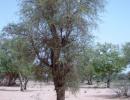
|
Soap berry tree
Scientific name:
Balanites aegyptiaca
Order/Family:
Zygophyllaceae
Local names:
Boran (Baddan); Digo (Mwambangoma); English (soap berry tree, simple-thorned torchwood, simple thorned torch tree, Jericho balsam, lalob tree, heglig, Egyptian myrobalan, desert date and torch wood); Gabra (Baddana); Giriama (Mkonga); Kamba (Mulului); Keiyo (Ng'osonaik); Kipsigis (N'oswet); Luo (Othoo); Maasai (Olokwai); Marakwet (Ngoswa); Mbeere (Mububua); Orma (Baddan); Pokot (Tuyunwo); Sabaot (Chuuandet); Samburu (Lowai); Swahili (mjunju,mwambangoma); Taita (Kiwowa); Taveta (Lungoswa); Teso (Echomai).
|
Introduction
An important tree found in Asia and all over Africa from arid and semi-arid regions to subhumid savanna. It is native to; Algeria, Angola, Benin, Burkina Faso, Burundi, Cameroon, Chad, Cote d'Ivoire, Democratic Republic of Congo, Djibouti, Egypt, Eritrea, Ethiopia, Gambia, Ghana, Guinea, India, Israel, Kenya, Libyan Arab Jamahiriya, Morocco, Myanmar, Nigeria, Saudi Arabia, Senegal, Somalia, Sudan, Tanzania, Uganda, Yemen, Republic of, Zambia and Zimbabwe. It is found in many parts of Kenya but rare at the coastal zone.
 |
| Distribution of Balanites aegyptiaca in Kenya |
| © Maundu P. and Bo Tengnas. (2005). Useful trees and shrubs for Kenya, World Agroforestry Centre. |
|
General Information about the Tree:
This is a very important species for dry areas as it produces fruit even in very dry years. Young leaves and tender shoots are used as a vegetable (Turkana, Pokot, Tugen, Marakwet, Keiyo, Ilchamus). Wood used for making boards for teaching the Koran.
Biophysical Limits: Altitude: it's found at 0 - 2,000 m in bushland and wooded grassland, Mean annual temperature: 20 - 30 deg. C, Mean annual rainfall: 250 - 1200 mm, Soil type: Common in open grassland with black-cotton soil. Prefers valley soil but will grow in sandy, clay, black-cotton, alluvial and stony soils and is found in agro-ecological zones IV - VI.
|
Propagation and Tree Management
Seedlings and direct sowing at site may be used to propagate it. It also produces suckers if roots are exposed which can also be used for propagation. Coppices and pollards well and can regenerate after lopping and heavy browsing. Where fruit is the principal interest,
pollarding and coppicing for obtaining fodder are seldom employed.
Products
- Food: The fleshy pulp of both unripe and ripe fruit is edible and eaten dried or fresh. The fruit is processed into a drink and sweetmeats in Ghana, alcoholic liquor in Nigeria, a soup ingredient in Sudan. Young leaves and tender shoots are used as a vegetable, which is boiled, pounded, then fried or fat added to prepare it.
- Fodder: The fresh and dried leaves, fruit and sprouts are all fed to livestock.
- Fuel: its wood is good firewood; it produces considerable heat and very little smoke, making it good for indoor use. It produces high-quality charcoal too.
- Fibre: A strong fibre is obtained from the bark.
- Timber: It has hard wood, durable, worked easily and made into yokes, wooden spoons, pestles, mortars, handles, stools and combs. It shows no serious seasoning defects and no tendency towards surface checking or splitting.
- Lipids: The kernels produce edible oil used for cooking, the oil remains stable when heated and has a high smoking point, and therefore its free fatty acid content is low.
- Alcohol: Its fruits may be used to brew an alcoholic drink.
- Poison: An emulsion made from the fruit or bark is lethal to the freshwater snails that are the host of miracidia and cercaria stages of bilharzia and to a water flea that acts as a host to the guinea worm. A fish poison can also be obtained from the fruit, root and the bark.
- Medicine: Decoction of root is used to treat malaria, roots boiled in soup are used against oedema and stomach pains. Roots are used as an emetic; bark infusion is used to treat heartburn. Wood gum mixed with maize meal porridge is used to treat chest pains. The bark is used to deworm cattle in Rajasthan.
- Other products: Seeds can be used for rosary beads, necklaces and in the game of warri played in Sudan.
Services:
- Shade or shelter: The usually evergreen behaviour potentially makes B. aegyptiaca an attractive element to introduce into shelterbelts, although it grows and hence not suitable as a principal species.
- Boundary or barrier or support: As a thorny tree, B. aegyptiaca is useful for fencing.
- Boundary and amenity plantings are widespread in Africa. Cut branches are used to make livestock enclosures.
Pests and Diseases
B. aegyptiaca is often attacked by locust and beetle and suffers a high degree of parasitic infestation. Two micro-fungi, Phorma balanitis and Septoria balanitis, are the only reported dependent fungi.
Information Source Links
- Maundu P. and Bo Tengnas. (2005)Useful trees and shrubs for Kenya, World Agroforestry Centre.
- Albrecht J. ed. 1993. Tree seed hand book of Kenya. GTZ Forestry Seed Center Muguga, Nairobi, Kenya.
- Beentje HJ. 1994. Kenya trees, shrubs and lianas. National Museums of Kenya.
- Bein E. 1996. Useful trees and shrubs in Eritrea; Regional Soil Conservation Unit (RSCU), Nairobi, Kenya.

 Back
Back

